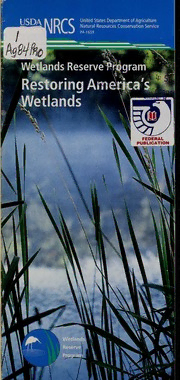
Wetland Reserve Program : restoring America's wetlands PDF
Preview Wetland Reserve Program : restoring America's wetlands
Historic, Archive Document Do assume not content reflects current scientific knowledge, policies, or practices. I I What the Is Wetlands Reserve Program? TheWetlands Reserve Program (WRP) is the Nation's premierwetlands restoration program. Itis avoluntaryprogram that offers landowners the means and the opportunityto protect, restore, and enhancewetlands on theirproperty.The USDANatural Resources Conservation Service (NRCS) manages the program aswell as provides technical andfinancial support to help landownerswho participate inWRP. Wetlands Reserve Program: • Is avoluntaryprogram offered nationwide. • Offers payment, based on the agriculturalvalue, for wetlands that have previouslybeen drained and converted to agricultural uses. • Pays up to 100 percent reimbursement for restoration costs. — • Lets landowners retain control ofaccess no public access is required. — • Lets landowners maintain ownership ofland they have the right to hunt, fish, trap, and pursue other appropriate recreational uses. • Allows for land, including anyeasement, to be sold. • Provides additional benefits for the entire community: - improved water quality - enhanced habitat for wildlife - reduced soil erosion - reduced flooding - improved water supply. • 1 Landowner Use and Responsibility In all cases, the landowner retains ownership and responsibilityfor the land, includinganypropertytaxes based on its reassessedvalue aswetland or nonagricul- tural land. The landowner controls access to the land; has the right to hunt, fish, trap, and pursue other appropriate recreational uses; and maysell or lease land enrolled inWRP. Thelandownermayrequestuseswhicharecompatible withprotectingandenhancingthewetlandandassociated uplandhabitat. Forexample, NRCS mayapprovehaying, grazing, orharvestingoftimberundercertainconditions, dependingon amount, method, timing, andduration. Landowners maymake compatible-use requests throughoutthelife oftheeasementoragreement. Restoredwetlandin Iowa. Eligibility Landowner To offer a conservation easement, you must have owned the land for at least 1 year prior to enrollment, with limited exceptions. To participate in a 10-year restora- tion cost-share agreement, you need onlyshowevidence ofownership. Land To be eligible forWRP, land must be restorable and be suitable forwildlife benefits. This includes: • Wetlands cleared and/or drained for farming, pasture, or timber production. • Lands adjacent to restorablewetlands that contribute significantlyto wetland functions andvalues. • Previouslyrestoredwetlands that need long-term protection. Nativeplants (swampmilkweed)restoredon WRPwetlands anduplands. • Upland areas needed to provide an adequate ecolog- ical buffer or that otherwise contribute to defining a manageable boundary. • Drainedwoodedwetlandswhere hydrologywill be fullyrestored. • Existing or restorable riparian habitat corridors that connect protectedwetlands. • Lands substantiallyaltered byfloodingwhere there is alikelihood ofsuccessfulwetland restoration at a reasonable cost. Ineligible Land • Wetlands converted after December 23, 1985. • Certain Conservation Reserve Program contractlands where trees have been successfullyestablished. • Federal lands. • Landswhere conditions make restoration impossible. Volunteersplanting treesin Louisiana to restore wetlands. 4 Landowner Options WRP offers three options to protect, restore, and enhance wetlands and associated uplands: permanent easements, 30-year easements, or 10-year restoration cost-share agreements. Permanent Easements This is a conservation easement in perpetuity. The ease- ment is attached to the property deed, ensuring that future owners ofthe propertywill preserve the wetland for generations. USDAwill pay 100 percent ofthe cost ofthe restoration and legal costs to establish the ease- ment. In addition, the landowner receives a payment for a permanent easementwhichwill be the lesser of: • The geographical area rate cap (available from your NRCS local office), • The appraised agriculturalvalue ofthe land, or • An amount offered by the landowner. 30-Year Easements These easements expire at the end of30 years. Easement payments are 75 percent ofwhatwould be paid for a permanent easement and 75 percent ofthe restoration costs. USDAwill paylegal costs associated with establishing the easement. Wetlandeasementprojectin Washington. 5
